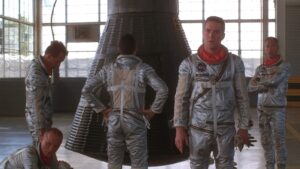Space is an infinite playground where filmmakers can let their imaginations run wild and audiences can explore distant worlds, frightening aliens, and anything in between. The National Aeronautics and Space Administration is exactly what it sounds like: the buttoned-up, facts-first organization that got us to space for real. When you are making a movie about an organization as methodical and prudent as NASA, how do you craft an engaging conflict to drive your story? There is no perfect approach—ever since Richard Donner’s “X-15” first depicted the space program in 1961, filmmakers have been looking for different angles to dramatize NASA.
Some invent worst-case scenarios that put the program through its paces, like “Marooned,” “Gravity,” or “The Martian” (or, in the case of “Apollo 13,” dramatize a real-life crisis). Some make biopics that lightly fictionalize NASA’s early days, like “The Right Stuff,” “Hidden Figures,” or “First Man.” Others take the program into the realm of science fiction in existential sagas like “Interstellar” and “Ad Astra.

” This constant urge to sex up NASA is central to the new romantic comedy “Fly Me to the Moon,” which opens at The Triplex this week. The story of a Madison Avenue marketing expert (Scarlett Johansson) brought in to revamp NASA’s image ahead of the Apollo 11 launch, “Fly Me to the Moon” operates as a meta-critique of Hollywood’s relationship with the space program. When Johanss.
















